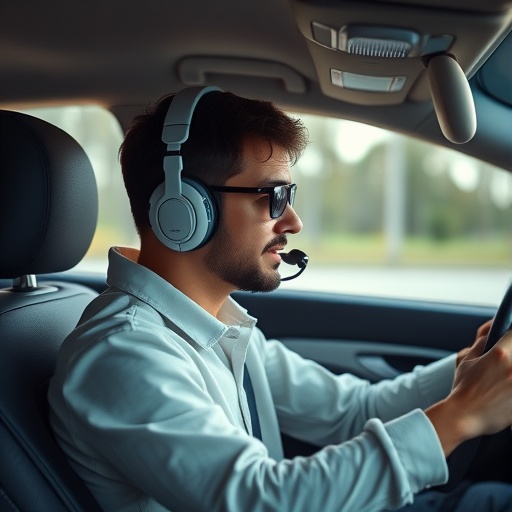In the rapidly evolving landscape of cognitive and behavioral science, the intersection of technology and emotion regulation is becoming a pivotal field of study, especially as it pertains to real-world applications like driving safety. Recent groundbreaking research led by Liu, Wang, and Zhu, published in BMC Psychology in 2025, has pioneered an in-depth investigation into how computer-aided emotion regulation strategies can influence risky driving behaviors within a controlled virtual environment. This study sheds new light on the intricate mechanisms by which digital interventions can modulate human emotions to promote safer decision-making behind the wheel.
Driving, by nature, is a complex, high-stakes activity laden with emotional triggers. Anxiety, anger, and frustration often escalate on the road, driving up the incidence of risky behaviors such as aggressive lane changes, speeding, and distracted driving. Liu and colleagues embarked on their research recognizing this emotional component as a critical leverage point. Utilizing advanced computer-aided tools, they sought to understand whether targeted emotion regulation could mitigate these detrimental behaviors, thereby enhancing road safety in a controlled, measurable manner.
The experimental framework utilized a sophisticated virtual driving simulation, meticulously designed to replicate real-life driving scenarios that typically provoke emotionally charged responses. Participants were exposed to situations like heavy traffic congestion, sudden braking by other drivers, and ambiguous right-of-way decisions—conditions known to provoke stress and impulsive reactions. The key innovation of the study lay in the deployment of two distinct computer-aided emotion regulation strategies designed to assist drivers in managing their emotional states in real-time.
The first strategy leveraged real-time biofeedback, allowing drivers to gain immediate awareness of physiological markers associated with emotional arousal, such as heart rate and skin conductance. Through subtle on-screen prompts and calming auditory cues, this approach encouraged participants to engage in deep-breathing exercises and cognitive reframing techniques. The second method implemented a predictive algorithm that anticipated impending emotional spikes based on historical behavioral data and contextual cues, automatically adjusting the virtual environment’s stimuli and offering proactive emotion regulation tips.
Data collected from hundreds of simulated driving sessions revealed compelling differences between the two approaches. Both strategies demonstrated a significant reduction in aggressive driving maneuvers and risky decision-making compared to baseline sessions without any emotion regulation assistance. However, the predictive algorithm exhibited unique advantages by preemptively attenuating emotional escalations, thereby preventing risk behaviors from manifesting at all rather than merely dampening them after onset.
Beyond behavioral outcomes, the study provided nuanced insights into the neural correlates of emotion regulation during driving, employing non-invasive neuroimaging tools alongside physiological measures. Results suggested enhanced activation in prefrontal regions responsible for executive control and emotional modulation when participants engaged with computer-aided strategies. This neurobiological evidence reinforces the conceptual framework that supporting drivers’ emotional self-regulation via technology taps into fundamental cognitive control networks.
From a technological perspective, the integration of machine learning models with biofeedback systems marks a significant advancement in driver assistance technologies. Liu and team’s innovative use of real-time data streams highlights the feasibility of embedding these emotion regulation modules into future in-car infotainment or safety systems. Such seamless integration could revolutionize road safety, making adaptive, personalized support a standard feature in vehicles.
Importantly, the virtual environment methodology employed in this research enhances ecological validity while preserving experimental control—a balance often elusive in behavioral studies. By simulating authentic driving challenges, the study captures genuine emotional reactions and decision patterns, providing robust evidence for the effectiveness of computer-aided intervention strategies. This methodological rigor establishes a strong foundation for subsequent translation into real-world trials.
Furthermore, the findings underscore the potential for these emotion regulation technologies to extend beyond individual benefits, potentially informing broader public safety campaigns and policy frameworks. By mitigating emotional triggers that precipitate reckless driving, these tools could contribute to meaningful reductions in traffic accidents and fatalities on a population scale. Researchers advocate for cross-disciplinary collaboration bridging psychology, engineering, and traffic safety authorities to fully realize this potential.
The implications of Liu et al.’s findings innovate the paradigm of driver safety away from purely mechanical or regulatory interventions toward a more holistic model encompassing psychological wellbeing. As vehicles become increasingly autonomous, human-machine interaction will necessitate adaptive systems to not only control vehicles but also optimize human emotional states, ensuring harmonious shared control that prioritizes safety and comfort.
Skeptics might argue about the scalability of virtual environment results to unpredictable, real-world conditions. However, by integrating adaptive algorithms that learn from continuous driver feedback, future systems may evolve dynamically to manage diverse emotional and environmental complexities beyond simulation confines. This adaptability could tailor interventions uniquely to each driver’s emotional profile and driving habits.
Ethical considerations surrounding the deployment of emotion regulation technologies invite dialogue concerning data privacy, consent, and user autonomy. Ensuring transparent algorithms and safeguarding sensitive emotional data are paramount to fostering trust and widespread adoption. Liu and colleagues highlight the necessity of embedding ethical frameworks alongside technological innovation.
Looking ahead, ongoing research aims to validate these computer-aided strategies in large-scale naturalistic driving studies, incorporating diverse demographic groups to examine cross-cultural applicability. Moreover, exploring multimodal sensory inputs such as voice tone and facial expressions could further enhance emotion recognition and regulation precision.
In sum, this pioneering study marks a transformative step in understanding how cutting-edge technology can interface with human emotion to recalibrate risky behaviors. It opens promising avenues not only for driving safety but for any high-stress scenario where emotion-driven impairments jeopardize performance. As digital tools become ever more sophisticated, the prospect of harmonizing human affect with machine intelligence offers a compelling future for safer, more mindful mobility.
Subject of Research: Computer-aided emotion regulation strategies and their impact on risky driving behaviors in virtual environments.
Article Title: The impact of two computer-aided emotion regulation strategies on risky driving behaviors in a virtual environment.
Article References:
Liu, J., Wang, X. & Zhu, L. The impact of two computer-aided emotion regulation strategies on risky driving behaviors in a virtual environment. BMC Psychol 13, 865 (2025). https://doi.org/10.1186/s40359-025-03211-z
Image Credits: AI Generated




